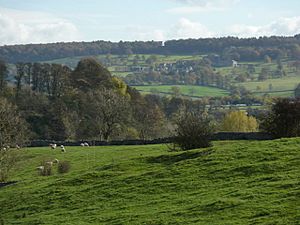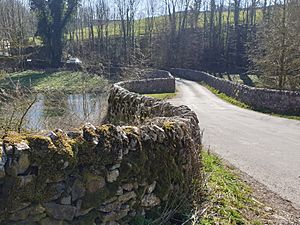Conksbury facts for kids

Site of Conksbury village looking towards Stanton in Peak
|
|
| Location | Youlgreave |
|---|---|
| Region | Derbyshire, England |
| Coordinates | 53°11′00″N 1°41′50″W / 53.18333°N 1.69722°W |
| Type | Settlement |
| History | |
| Periods | Middle Ages |
| Site notes | |
| Condition | Buried remains |
| Public access | Public road on south edge |
| Official name | Conksbury deserted medieval settlement |
| Reference no. | 1014589 |
Conksbury is the site of a deserted medieval village located between Over Haddon and Youlgreave in Derbyshire, England. Today, you can still see the remains of this old settlement.
Contents
A Glimpse into Conksbury's Past
Conksbury was first mentioned in a very important book called the Domesday Book in 1086 AD. This book was a huge survey ordered by William the Conqueror to record everything in England after he became king.
Life in the Medieval Village
In the Domesday Book, Conksbury was called Cranchesberie. It was part of a larger royal estate centered around Bakewell. The records show that many people lived there. There were 35 villagers and 16 smallholders, who were like tenant farmers. Two priests and a soldier also lived in the area.
The villagers were busy farmers. They had many fields for growing crops. There were also large meadows for their animals. A forest provided wood and hunting grounds. The village even had a mill to grind grain into flour. There was also a church, which was very important to daily life.
Who Owned Conksbury?
Before William the Conqueror, the land belonged to Edward the Confessor, the English king. After the Norman Conquest, King William owned it. He later gave the large estate of Bakewell, which included Conksbury, to a Norman knight named William Peverel.
Peverel later started a religious house called Lenton Priory. He built a special farm, known as a monastic grange, near Conksbury for the priory. Over time, Conksbury and its mill were given to another religious house, the Abbey of St Mary de Pre.
Changes Over the Centuries
In the 1500s, during the time of the dissolution of the monasteries, the King took back control of many church lands. Conksbury and Meadow Place became property of the Crown.
By 1610, the Cavendish family bought the land. It then became part of the large estate owned by the Duke of Devonshire. Today, the site of the old village is a protected scheduled monument. This means it's an important historical place that is kept safe. You can still see the outlines of old buildings and fences in the ground.
Conksbury Bridge
The Conksbury medieval bridge crosses the River Lathkill. It is a very old and important structure. The bridge was built in the mid-1700s. It is made from strong limestone rocks.
This bridge carries the road between Bakewell and Youlgreave. In 1758, a special law allowed people to collect tolls (money) from those who used the bridge. The bridge has three main arches. It also has pointed sections called cutwaters. These help the bridge stand strong against the river's flow.
Nearby Historic Buildings
Conksbury Hall is an 18th-century house. It is made of gritstone and stands on the western edge of the old village site. This hall is a Grade II listed building, meaning it's historically important.
Conksbury Farmhouse is also a Grade II listed building. It dates back to 1725. You can even see the date carved above its door!


